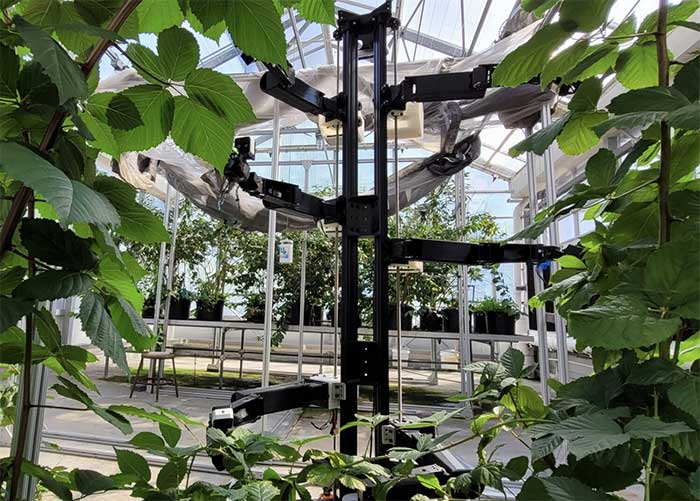Six-armed pollination robot works in a greenhouse
Thanks to its 6 arms, the Stickbug robot can pollinate many flowers at the same time at a rate of 1.5 pollinations per minute.
Stickbug pollination robot. Video: WVUIRL
To solve the problem of endangered pollinators, especially some species of bees, moths, butterflies and flies, a research team from West Virginia University developed a pollination robot called Stickbug , Interesting Engineering reported on May 1. New research published on the arXiv database .
Stickbug is specifically designed for greenhouse environments. The robot aims to move easily between narrow aisles using a Kiwi drive system . It also has a probe and sorter that helps identify target flowers. It will conduct contact pollination using an end effector (the end of the robot arm) with a felt-covered tip.

Robots focus on precision, flexibility, and access to resources.
With 6 arms and 6 controllers, Stickbug can pollinate multiple flowers at the same time and perform different tasks independently. The robot focuses on precision, flexibility and access to resources, such as publicly available data about black raspberries.
In the actual test, the Stickbug prototype was placed in front of an artificial black raspberry tree because it was not the natural flowering season. The robot is responsible for pollinating as many flowers as possible within 5 minutes. Initial testing shows that Stickbug can perform 1.5 pollination attempts per minute with a success rate of about 50%.
The research team plans to conduct further research with tests on real trees during the flowering season. If it successfully passes all levels of testing, Stickbug will be a promising solution to compensate for the decline of natural pollinators, contributing to ensuring global food security.
- Pollination crisis: myths?
- In Spain there is a greenhouse area planted close to trees, visible from orbit
- Story of the autonomous bee robot squad
- Robot works like sperm
- Iraq buys super bomb detonator
- Early detection of fossil insect pollination
- Self-propelled armed robots will be 'infinite disaster'
- Robot goes to battle
- Flex - Robot snakes into the body through the mouth for surgery
- The tree cannot be immortal without pollination
- Humanoid robot: How realistic is it?
- Video: The most humanoid robot of the US military
 The US company is about to build a supersonic passenger plane of 6,000km / h
The US company is about to build a supersonic passenger plane of 6,000km / h Japan develops avatar robot as in fiction film
Japan develops avatar robot as in fiction film Australia tested the world's first mango picking robot
Australia tested the world's first mango picking robot America develops technology to separate water from animal waste
America develops technology to separate water from animal waste America invented a test that can detect 50 forms of cancer
America invented a test that can detect 50 forms of cancer  Is it possible that the pyramid's latitude strangely coincides with the speed of light?
Is it possible that the pyramid's latitude strangely coincides with the speed of light?  Why could 2024 be the hottest year in history?
Why could 2024 be the hottest year in history?  Why does iPhone lose battery when left overnight?
Why does iPhone lose battery when left overnight?  Why do pilots have to wear sunglasses when flying?
Why do pilots have to wear sunglasses when flying?  Norway builds the world's largest hydrogen ship
Norway builds the world's largest hydrogen ship 